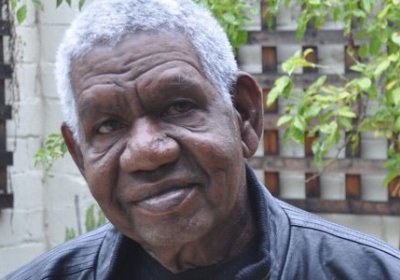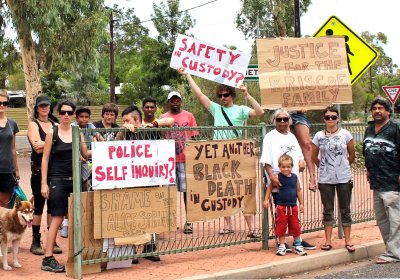In the early hours of June 29, the Australian Senate passed legislation that is expected to entrench assimilation, disadvantage and racism for another decade in the Northern Territory.
Northern Territory Intervention (NTER)
July 1 is the new financial year and the start of many new government policies. This year, the carbon and mining taxes, and expansion of income management, or welfare quarantining, to five new locations.
People receiving Centrelink payments and living in Playford in South Australia, Logan and Rockhampton in Queensland, Greater Shepparton in Victoria, and Bankstown in NSW may be subject to the new system.
The carbon and mining taxes have generated hysterical debate, but the extension of income management has been noticeably underreported.
This article first appeared in Tracker magazine on March 19.
* * *
Aboriginal leaders in the Northern Territory have issued a strong warning that the Australian government’s new land grab in the form of the proposed 10-year extension of the intervention will send many communities into a dangerous downward spiral with still more death and misery.
Aboriginal rights protesters gathered outside the Northern Territory tourism bureau in Sydney on March 21 to protest the death in custody of 28-year-old Aboriginal man Terrence Briscoe, and to condemn the “Stronger Futures” bill that will extend the NT intervention.
Deaths in custody campaigner Ray Jackson told the rally: “When Terrence died in a police cell, the family were first told it was a heart attack. Then it was respiratory. Then it was asphyxiation. How do you asphyxiate? When police jump all over you, forcing your breath out.
As 2000 Aboriginal people and their supporters gathered at the 40th anniversary celebrations of the Tent Embassy in Canberra, Coalition leader Tony Abbott said: “I can understand why the Tent Embassy was established all those years ago. I think a lot has changed for the better since then… I think it probably is time to move on from that.”
Aboriginal affairs minister Jenny Macklin released the Stronger Futures in the Northern Territory Report on Consultations on October 18. The federal government facilitated “community consultations” across the NT between June and August, discussing future policy toward Aboriginal communities after the Northern Territory Emergence Response (NT intervention) legislation expires in June next year.
Salil Shetty, Amnesty International’s secretary-general, has slammed the Northern Territory intervention, saying that it is making the problems facing Aboriginal Australians worse, AAP reported on October 7.
He said the government’s “top-down externally driven” efforts to close the gap on Aboriginal socio-economic disadvantage were instead having the opposite effect”. Amnesty was appalled that current policies had in effect caused “forced evictions from their traditional homelands”.
iNTervention Intervention
Curated by Teena McCarthy & Brendan Penzer
The Vanishing Point gallery
565 King Street, Newtown, Sydney
January 13-30
“The time has now come for the nation to turn a new page in Australia’s history by righting the wrongs of the past and so moving forward with confidence to the future....
“We apologise especially for the removal of Aboriginal and Torres Strait Islander children from their families, their communities and their country....
Your article “What's behind the NT intervention” (GLW #843) outlines the government's goal of forced assimilation of Aboriginal communities.
Under the intervention, millions of dollars worth of assets and housing has been seized from Aboriginal community councils and thousands of Aboriginal jobs have been lost as Community Development Employment Projects (CDEP) close down.
Then prime minister John Howard declared in 2007 that: "Aboriginal people have no future outside the Australian mainstream.”
One of Australia’s richest men, mining magnate Andrew “Twiggy” Forrest, used Australian television on October 24 to send an address to the nation about his “Generation One” campaign, which aims to “close the gap” between Indigenous and non-Indigenous Australians.
I don’t have any air-time, but I do have page space. This is my address to Twiggy.
* * *
Dear Mr Forrest,
I think we have something in common (yes, I’m surprised too).
Mining magnate Andrew “Twiggy” Forrest had an opportunity on ABC’s November 1 screening of Q&A to defend his record on Aboriginal employment. He didn’t do very well.
“You can see that through Generation One, a real challenge to fill those jobs, because we've proven for all time that corporate Australia — in fact every Australian — isn't racist”, Forrest said.
“We do love our first Australians. We do want to help them as much as we can but we can do it without just throwing money, and I believe I could do more.”
King Brown Country: The Betrayal of Papunya
by Russell Skelton
260 pages
Allen & Unwin
$35
REVIEW BY MAT WARD
The Northern Territory community of Papunya is known worldwide for its Aboriginal art. But this book by Melbourne Age reporter Russell Skelton paints a very different picture of it.
Papunya, says Skelton, is "a metaphor for all that has gone wrong with Indigenous policy since the 1970s". He says former prime minister Gough Whitlam's policy of self-determination for Aboriginal communities in the 1970s was "unworkable and unsustainable".
- Previous page
- Page 3
- Next page










